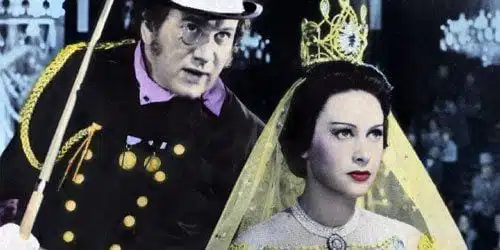
“Her name was Lola. She was a showgirl.” We all know the immortal words that open Barry Manilow’s timeless “Copacabana”, but who would have thought that they would be such a great starting point in a discussion of Max Ophüls’ misunderstood classic Lola Montes?
Ophüls’ Lola is indeed a kind of a showgirl, she is the shining jewel centerpiece of a grand, swirling circus that serves as a framing device in the film for telling the viewer her story. Who is Lola Montes? Who is the woman behind the crumbly facade of this traveling show? Does it even matter who she is?
From the very beginning, it is important to realize that Lola (Martine Carol), while the subject of this film, is also it’s object. She is an object of desire, ridicule, gossip. She is a legend in her own time, a broken, alcoholic beauty who has wooed King Ludwig I of Bavaria (played here by the always-amazing Anton Walbrook of The Red Shoes) and Franz Liszt, created scandals and charted her own unique course through life.
She’s not unlike a reality television star – marginally talented, with her true gift lying in the fact that she knows how to best exploit herself. Lola is a figure on which ideas are expressed. Music, dance, stormy emotion, light, gesture all conspire to craft an intricate identity both for the film and for the character.
Ophüls stages a complicated carnivale, a ballet royale that is often reflexive in its ruthless self-reflexive presentation of the show within the show, or mise en abyme that presents two “mirror” versions of Lola for the spectator: one (broken) version performing her own life story for throngs of onlookers, the other a dream version of her in flashbacks leading up to the present.
Ophüls sets the stage for a breathtaking seduction of his audience. With the dynamic opening sequence that introduces Lola and the flashback-structured main conceit of the film, the director creates one of the most whimsical, energetically-directed prologues that I have seen put to film. The arrival of Lola and the circus in concert with the sheer audacity of Ophüls’ brilliant, virtuosic technical achievement is just a pure cinematic thrill, a pure spectacle that dazzles the eyes with outrageous colors and patterns of light.
This gorgeously-realized tableaux vivant is dripping with baubles, papier mache orbs, and light and festooned with feathers, bells and whistles, the film creates a style that is singular to its maker: a look and aesthetic that defines opulence. In a seminal review, critic Andrew Sarris called Lola Montes the greatest film of all time, so that type of hyperbole doesn’t feel too off-base given the meticulous way in which Ophüls constructs his mise-en-scène.
As in his classic The Earrings of Madame De…, the director showcases elegant textures, luscious Technicolors that seem to not exist in true nature. Lola Montes, both the movie and the character are lacquered with a glossy veneer, mysterious and complex underneath but on the surface they are beautiful, jewel-adorned fantasies.
This is a stunning celebration of aesthetic perfection and to know that Lola Montes was also Ophüls final film is disheartening, but cinephiles can rejoice in Criterion’s sumptuous offering of the film’s crisp, eye-popping transfer. In fact, Criterion has culled some of Ophüls’ greatest achievements and reinvigorated them for new generations to marvel at — La Plasir, La Ronde and Madame De… catapult the director to auteur status and Lola Montes confirms his place in the pantheon of great directors who employ melodrama, technical virtuosity and innovation to tell stories about women that time has either been cruel to or forgotten.
Without the spectacle of films such as this one, there would be no Bas Luhrmann (Moulin Rouge in particular borrows heavily in terms of style from Lola Montes), and Rainer Werner Fassbinder might have not have chosen to end his BRD trilogy with the homage Lola. The influence of this forgotten, misunderstood tale of a doomed female footnote in history has influenced countless contemporary and classic filmmakers stylistic choices and once it reaches a new generation, the possibilities for it infecting new artistic processes are infinite.
On the extras disc, which is an absolutely essential supplement for understanding the film’s complex production history, such luminaries as Simone Simon, Danielle Darrieux and John Houseman present tributes to the great director who is alternately referred to as “a coquette”, “fascinating” and a “petty tyrant”, among a litany of other contradicting adjectives from a variety of first-hand sources. One interviewee discusses how Ophüls thought of his star Carol as a “monster” because, in a twist that instantly recalls David Lynch’s Hollywood satire Mulholland Drive, she was chosen by the producers to play the lead role and Ophüls had no say in the matter.
As usual, the Criterion packaging and artwork are artfully done and the extras disc makes their offering a true collector’s edition. Now, Ophülsian enthusiasts just need Letter from an Unknown Woman, Criterion.

- Francis Ford Coppola's 'Live Cinema and Its Techniques' - PopMatters
- The Weeping Meadow (2004) - PopMatters
- Abnormally Attracted to Sin: Tori Amos Talks with PopMatters ...
- Surreal Visions of a Girls' Boarding School: Audry's Olivia - PopMatters
- Kenji Mizoguchi to Satyajit Ray
- The Classic 'Letter from an Unknown Woman' Makes One Wonder ...
- Le Plaisir - PopMatters
